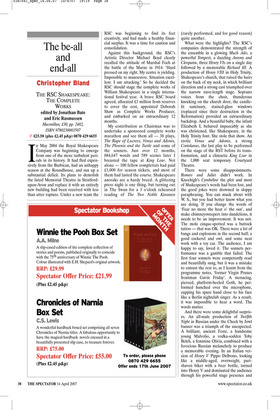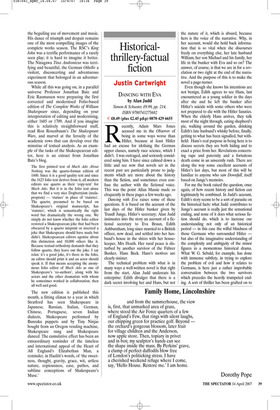The be-all and end-all
Christopher Bland
THE RSC SHAKESPEARE: THE COMPLETE WORKS edited by Jonathan Bate and Eric Rasmussen Macmillan, £30, pp. 2482, ISBN 9780230003507 ✆ £25.50 (plus £2.45 p&p) 0870 429 6655 In May 2004 the Royal Shakespeare Company was beginning to emerge from one of the more turbulent periods in its history. It had fled expensively from the Barbican, had an unhappy season at the Roundhouse, and run up a substantial deficit. Its plans to demolish the listed Memorial Theatre in Stratfordupon-Avon and replace it with an entirely new building had been received with less than utter rapture. Under a new team the RSC was beginning to find its feet creatively, and had made a healthy financial surplus. It was a time for caution and consolidation.
Against this background, the RSC’s Artistic Director Michael Boyd clearly recalled the attitude of Marshal Foch at the battle of the Marne in 1914: ‘Hard pressed on my right. My centre is yielding. Impossible to manoeuvre. Situation excellent. I am attacking.’ So he decided the RSC should stage the complete works of William Shakespeare in a single international festival year. A brave RSC board agreed, allocated £3 million from reserves to cover the cost, appointed Deborah Shaw as Complete Works Producer, and embarked on an extraordinary 12 months.
My contribution as Chairman was to undertake a sponsored complete works marathon and see them all — 38 plays, The Rape of Lucrece, Venus and Adonis, The Phoenix and the Turtle and some of the sonnets. Just over 12 months, 884,647 words and 589 scenes later I breasted the tape at King Lear. Not alone — 100 fellow completists had paid £1,000 for season tickets, and most of them had lasted the course. Shakespeare anoraks are a hardy breed. A glittering press night is one thing, but turning out in The Swan for a 3 o’clock rehearsed reading of The Two Noble Kinsmen (rarely performed, and for good reason) quite another.
What were the highlights? The RSC’s companies demonstrated the strength of the ensemble in a glowing Much Ado, a powerful Tempest, a dazzling Antony and Cleopatra, three Henry VIs on a single day followed by a memorable Richard III. A production of Henry VIII in Holy Trinity, Shakespeare’s church, that raised the hairs on the back of my neck, in which brilliant direction and a strong cast triumphed over the narrow nave-length stage. Soprano voices from the choir, thunderous knocking on the church door, the candlelit sanctuary, stained-glass windows (replaced since their destruction in the Reformation) provided an extraordinary backdrop. And a beautiful baby, the infant Elizabeth I, behaved impeccably as she was christened, like Shakespeare, in the Holy Trinity font. She stole that show. An erotic Venus and Adonis, a strong Coriolanus, the last play to be performed on the stage of the RST before its transformation, and a climactic King Lear in the 1,000 seat temporary Courtyard Theatre.
There were some disappointments. Romeo and Juliet didn’t work. In Kneehigh’s Cymbeline the plot and most of Shakespeare’s words had been lost, and the good jokes were drowned in sloppy paraphrasing. You can muck about with W. S., but you had better know what you are doing. If you change the words of ‘Fear no more the heat o’ the sun’, and make chimneysweepers into dandelions, it needs to be an improvement. It was not. The mole cinque-spotted was a buttock tattoo — that was OK. There were a lot of bangs and explosions in the second half; a good cockerel and owl, and some neat work with a toy car. The audience, I am happy to say, loved it. The sonnets performance was a gamble that failed. The first four sonnets were competently read and beautifully sung, but it was a mistake to entrust the rest to, as I learnt from the programme notes, ‘former Virgin Prunes frontman Gavin Friday’. A menacing, pierced, platform-heeled Goth, he performed hunched over the microphone, cupping his spare hand close to his face like a Berlin nightclub singer. As a result, it was impossible to hear a word. The words matter.
And there were some delightful surprises. An all-male production of Twelfth Night in Russian under the Cheek by Jowl banner was a triumph of the unexpected. A brilliant, ancient Feste, a handsome young Malvolio, a vodka-sodden Toby Belch, a feminine Olivia, combined with a ferocious Russian melancholy to produce a memorable evening. In an Italian version of Henry V Pippo Delbono, looking like a middle-aged, overweight, partshaven biker with a beer bottle, turned into Henry V and dominated the audience through his powerful stage presence and the beguiling use of movement and music. His dance of triumph and despair remains one of the most compelling images of the complete works season. The RSC’s King John was a terrific performance of a rarely seen play; it is hard to imagine it better. The Ninagawa Titus Andronicus was terrifying and beautiful, the German Othello a violent, disconcerting and adventurous experiment that belonged in an adventurous season.
While all this was going on, in a parallel universe Professor Jonathan Bate and Eric Rasmussen were preparing the first corrected and modernised Folio-based edition of The Complete Works of William Shakespeare since, depending on your interpretation of editing and modernising, either 1685 or 1709. And if you imagine this is relatively straightforward stuff, read Ron Rosenbaum’s The Shakespeare Wars, and marvel at the ferocity of the academic rows that can develop over the minutiae of textual analysis. As an example of the tasks of the Shakespearean editor, here is an extract from Jonathan Bate’s blog.
The first printed text of Much Ado About Nothing was the quarto-format edition of 1600. Since it is a good quality text and since the 1623 folio text derives from it, all modern editors use quarto as their ‘copy-text’ for Much Ado. But it is in the folio text alone that we find a very nice Dogberryism (malapropism) — ‘statues’ in place of ‘statutes’. The quarto, presumed to be based on Shakespeare’s original manuscript, has ‘statutes’, which is semantically the right word but dramatically the wrong one. We simply do not know whether the folio editor restored a Shakespearean joke that had been obscured by a quarto misprint or inserted a joke that Shakespeare should have made but didn’t. Shakespearean editors agonise about this distinction and 10,000 others like it. Because textual orthodoxy demands that they follow quarto, they leave out the joke. I say relax: it’s a good joke, it’s there in the folio, an editor should print it and an actor should speak it. If that means accepting the anonymous folio editor of Much Ado as one of Shakespeare’s ‘co-authors’, along with his actors and the other dramatists with whom he sometimes worked in collaboration, then all well and good.
The new edition is published this month, a fitting climax to a year in which Stratford has seen Shakespeare in Japanese, Russian, Italian, German, Chinese, Portuguese, seven Indian dialects, Shakespeare performed by Bunraku puppets and by Tiny Ninjas bought from an Oregon vending machine, Shakespeare sung and Shakespeare danced. The cumulative effect has been an extraordinary reminder of the timeless and international appeal of the Heart of All England’s Elizabethan Man, a reminder, in Hazlitt’s words, of ‘the sweetness, thought, gravity, grace, wit, artless nature, copiousness, ease, pathos, and sublime conceptions of Shakespeare’s Muse.’



































































 Previous page
Previous page